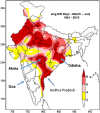Climate Change and the Emergent Epidemic of CKD from Heat Stress in Rural Communities: The Case for Heat Stress Nephropathy
- PMID: 27151892
- PMCID: PMC4974898
- DOI: 10.2215/CJN.13841215
Climate Change and the Emergent Epidemic of CKD from Heat Stress in Rural Communities: The Case for Heat Stress Nephropathy
Abstract
Climate change has led to significant rise of 0.8°C-0.9°C in global mean temperature over the last century and has been linked with significant increases in the frequency and severity of heat waves (extreme heat events). Climate change has also been increasingly connected to detrimental human health. One of the consequences of climate-related extreme heat exposure is dehydration and volume loss, leading to acute mortality from exacerbations of pre-existing chronic disease, as well as from outright heat exhaustion and heat stroke. Recent studies have also shown that recurrent heat exposure with physical exertion and inadequate hydration can lead to CKD that is distinct from that caused by diabetes, hypertension, or GN. Epidemics of CKD consistent with heat stress nephropathy are now occurring across the world. Here, we describe this disease, discuss the locations where it appears to be manifesting, link it with increasing temperatures, and discuss ongoing attempts to prevent the disease. Heat stress nephropathy may represent one of the first epidemics due to global warming. Government, industry, and health policy makers in the impacted regions should place greater emphasis on occupational and community interventions.
Keywords: Chronic; Climate; Climate Change; Dehydration; Health Policy; Heat Exhaustion; Hot Temperature; Physical Exertion; Renal Insufficiency; Rural Population; chronic kidney disease.
Copyright © 2016 by the American Society of Nephrology.
Figures






References
-
- Fischer EM, Knutti R: Anthropogenic contribution to global occurrence of heavy precipitation and high temperature extremes. Nat Clim Chang 5: 560–565, 2015
-
- Meehl GA, Tebaldi C: More intense, more frequent, and longer lasting heat waves in the 21st century. Science 305: 994–997, 2004 - PubMed
-
- Morak S, Hegerl G, Christidis N: Detectable changes in the frequency of temperature extremes. J Clim 26: 1561–1564, 2013
-
- Pai DS, Nair SA, Ramanthan AN: Long term climatology and trends of heat waves over India during the recent 50 years (1961-2010). Mausam (New Delhi) 64: 585–604, 2013
Publication types
MeSH terms
Grants and funding
LinkOut - more resources
Full Text Sources
Other Literature Sources
Medical
Molecular Biology Databases

